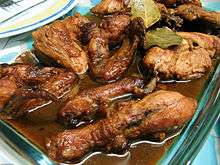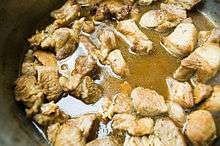Philippine adobo
 Chicken adobo | |
| Course | Main course |
|---|---|
| Place of origin | Philippines |
| Region or state | Ilocos |
| Associated national cuisine | Filipino cuisine |
| Serving temperature | Hot |
| Main ingredients | Meat (beef, chicken, pork), soy sauce, vinegar, cooking oil, garlic, black peppercorn, bay leaf |
| Variations | Some sugar for sweet-salty taste |
| Generic Filipino pork adobo (342 calories[1]), beef adobo (349 calories[2]), chicken adobo (107 calories[3]) kcal | |
Philippine adobo (from Spanish adobar: "marinade," "sauce" or "seasoning") is a popular Filipino dish and cooking process in Filipino cuisine that involves meat, seafood, or vegetables marinated in vinegar, soy sauce, garlic, and black peppercorns, which is browned in oil, and simmered in the marinade. It has sometimes been considered as the unofficial national dish in the Philippines.[4]
History
The cooking method is indigenous to the Philippines. Early Filipinos cooked their food normally by roasting, steaming or boiling methods. To keep it fresh longer, food was often cooked by immersion in vinegar and salt. Thus, it is very likely that Filipinos could have been cooking meat in vinegar as a means of preservation. This process dates back to the Pre-Hispanic Period and was used for pork and chicken.[5][6][7][8]
When the Spanish Empire colonized the Philippines in the late 16th century and early 17th century, they encountered this cooking process. It was first recorded in the dictionary Vocabulario de la Lengua Tagala (1613) compiled by the Spanish Franciscan missionary Pedro de San Buenaventura. He referred to it as adobo de los naturales ("adobo of the native peoples").[6][7][8] Dishes prepared in this manner eventually came to be known by this name, with the original term for the dish now lost to history.[9][10]
The Spanish also applied the term adobo to any native dish that was marinated before consumption. In the 1794 edition of Vocabulario de la lengua Tagala, it was applied to quilauìn (kinilaw) a related but different dish which also primarily uses vinegar.[11] In Vocabulario de la lengua Bisaya (1711), the term guinamus (verb form: gamus) was used to refer to any kind of marinades (adobo), from fish to pork. In modern Cebuano, guinamos refers to an entirely different dish - bagoong.[12]
Description

While the adobo dish and cooking process in Filipino cuisine and the general description of adobo in Spanish cuisine share similar characteristics, they refer to different things with different cultural roots. While the Philippine adobo can be considered adobo in the Spanish sense—a marinated dish—the Philippine usage is much more specific to a cooking process (rather than a specific recipe) and is not restricted to meat.[13] Typically, pork or chicken, or a combination of both, is slowly cooked in vinegar, crushed garlic, bay leaves, black peppercorns, and soy sauce. It is served with white rice.[6][14][15] It was traditionally cooked in small clay pots (palayok or kulon); but in modern times, metal pots or woks (kawali) are used instead.[16]
There are numerous variants of the adobo recipe in the Philippines.[9] The most basic ingredient of adobo is vinegar, which is usually coconut vinegar, rice vinegar, or cane vinegar (although sometimes white wine or cider vinegar can also be used). Almost every ingredient can be changed according to personal preference. Even people in the same household can cook adobo in significantly different ways.[13][15] A rarer version without soy sauce is known as adobong puti ("white adobo" or "blond adobo"), which uses salt instead, to contrast it with adobong itim ("black adobo"), the more prevalent versions with soy sauce.[17][18] Adobong puti is often regarded as the closest to the original version of the Pre-Hispanic adobo.[13][19] It is similar to another dish known as pinatisan, where patis (fish sauce) is used instead of vinegar.[20]

The proportion (or even the presence) of ingredients like soy sauce, bay leaves, garlic, or black pepper can vary. Other ingredients can sometimes be used; like siling labuyo, bird's eye chili, jalapeño pepper, red bell pepper, olive oil, onions, brown sugar, potatoes, or pineapple. It may also be further browned in the oven, pan-fried, deep-fried, or even grilled to get crisped edges.[15][21]
There are also regional variations. In southern Luzon (Bicol region), and Muslim Zamboanga, for example, it is common to see adobo cooked with coconut milk (known as adobo sa gatâ). In Cavite, mashed pork liver is added. In Laguna, turmeric was added, giving the dish a distinct yellowish color (known as adobong dilaw, "yellow adobo").[6][15]
Adobo has also become a favorite of Filipino-based fusion cuisine, with avant-garde cooks coming up with variants such as "Japanese-style" pork adobo.[22]
Based on the main ingredients, the most common adobo dishes are adobong manok, in which chicken is used, and adobong baboy, in which pork is used. Adobong baka (beef), along with adobong manok (chicken), is more popular among Muslim Filipinos.[23] Other meat sources may also be used, such as adobong pugò (quail), adobong itik (duck), adobong kambing (goat).[13] There are also seafood variants which can include fish (adobong isda), catfish (adobong hito), shrimp (adobong hipon), and squid or cuttlefish (adobong pusit). It can even be used to cook vegetables and fruits,[16] like water spinach (adobong kangkong), bamboo shoots (adobong labong), eggplant (adobong talong), banana flowers (adobong pusô ng saging), and okra (adobong okra).[24][25]
Even more exotic versions include adobong sawâ (snake),[26] adobong palakâ (frogs),[27] Kapampangan adobung kamaru (mole crickets),[13] and the adobong atay at balunbalunan (chicken liver and gizzard).[28]
Adobo has been called the quintessential Philippine stew, served with rice both at daily meals and at feasts.[14] It is commonly packed for Filipino mountaineers and travelers because it keeps well without refrigeration. Its relatively long shelf-life is due to one of its primary ingredients, vinegar, which inhibits the growth of bacteria.[6]
Other uses
Outside of the dish itself, the flavor of adobo has been developed commercially and adapted to other foods. A number of local Philippine snack products such as nuts, chips, noodle soups, and corn crackers, market their items as "adobo flavored".
See also
- Cuisine of the Philippines
- List of Philippine dishes
- Paksiw, another Philippine cooking method that uses vinegar
References
- ↑ http://www.myfitnesspal.com/food/calories/generic-filipino-pork-adobo-325988545
- ↑ http://www.fatsecret.com/Diary.aspx?pa=fjrd&rid=255665
- ↑ https://www.fatsecret.com/calories-nutrition/generic/chicken-adobo
- ↑ DeWitt, Dave (2010). 1,001 Best Hot and Spicy Recipes. Agate Publishing. p. 428. ISBN 9781572841130.
- ↑ http://asianjournal.wordpress.com/2008/07/14/adobo-a-history-of-the-countrys-national-dish/
- 1 2 3 4 5 Rodell, Paul A. (2002). Culture and Customs of the Philippines. Culture and Customs of Asia. Westport, CT: Greenwood Publishing Group. p. 102. ISBN 9780313304156.
- 1 2 Estrella, Serna (June 22, 2013). "Adobo: The History of A National Favorite". Pepper.ph. Retrieved March 21, 2016.
- 1 2 Hosking, Richard (2006). Authenticity in the Kitchen: Proceedings of the Oxford Symposium on Food and Cookery 2005. Oxford Symposium. p. 299. ISBN 9781903018477.
- 1 2 Ocampo, Ambeth. (February 24, 2009). "Looking Back: 'Adobo' in many forms". Philippine Daily Inquirer. Archived from the original on May 23, 2015. Retrieved August 4, 2010.
- ↑ Rappaport, Rachel (2010). The Everything Healthy Slow Cooker Cookbook. Adams Media. p. 255. ISBN 9781440508486.
- ↑ Domingo de los Santos (1794). Vocabulario de la lengua Tagala, primera y segunda parte: en la primera, se pone primero el Castellano, y despues el Tagalo : y en la segunda al contrario, que son las rayzes simples con sus accentos. N.S. de Loreto. p. 42.
Adobo. Quilauìn. (pc) toman sàl vinagre, y chíle, y lo echan en la carne, pescado, ò tripas de venado; y asi medio crudo lo comen . . . Este mismo genero de adobo sirve para las yervas como ensalada.
- ↑ R. P. Matheo Sanchez (1711). Vocabulario de la lengua Bisaya. Colegio de la Sagrada Compania de Jesus. p. 198.
Gamus. up. f Gamusun vel. gamsun. Salar o adobar carne, o pescado; ba cun gagamsun an isda sagan sin saguing, sin chile, sua. &c
- 1 2 3 4 5 Claude Tayag (March 8, 2012). "The adobo identity (crisis)". The Philippine Star. Retrieved November 7, 2012.
- 1 2 Alan Davidson & Tom Jaine. (2006). The Oxford Companion to Food. New York: Oxford University Press. p. 5. ISBN 0-19-280681-5.
- 1 2 3 4 Sifton, Sam. (January 5, 2011). The Cheat: The Adobo Experiment. The New York Times. Retrieved January 7, 2011
- 1 2 Kittler, Pamela Goyan & Sucher, Kathryn (2007). The Culinary culture of the Philippines. Cengage Learning. p. 371. ISBN 9780495115410.
- ↑ Artie Sy (August 11, 2011). "The Admirable Adobo". Sun Star. Retrieved November 7, 2012.
- ↑ "Adobong Puti (White Chicken Adobo) for Kulinarya Cooking Club". FoodPress. June 19, 2011. Retrieved November 7, 2012.
- ↑ "The BEST Pork Adobo a la Marketman". Market Manila. May 7, 2008. Retrieved November 7, 2012.
- ↑ "Adobong Puti (White Adobo)". AdobongBlog. October 4, 2011. Retrieved November 7, 2012.
- ↑ Cordero-Fernando, Gilda (1976). The Culinary culture of the Philippines. Bancom Audiovision Corp. pp. 11–13.
- ↑ Manipon, Roel Hoang (2016-02-01). "Japanese-style adobo and other delicious things you can cook in a microwave oven". The Daily Tribune. Archived from the original on 2016-02-01. Retrieved 2018-03-23.
- ↑ Jeroen Hellingman (March 28, 2003). "Adobong Baka (Beef)". Bohol.ph. Retrieved November 7, 2012.
- ↑ Alejandro, Reynaldo G. (1985). The Philippine Cookbook. Penguin. pp. 52–60. ISBN 9780399511448.
- ↑ AdoboChef (January 5, 2011). Traditional Adobo Recipes Retrieved June 22, 2012
- ↑ "Only for the Daring: Exotic Food Finds in Cebu". Cebutourist. June 17, 2011. Archived from the original on January 19, 2013. Retrieved November 7, 2012.
- ↑ "Adobong Palaka". San Pablo City. October 14, 2010. Retrieved November 7, 2012.
- ↑ "Adobong Atay at Balunbalunan (Chicken Liver and Gizzard)". Reel and Grill. December 9, 2010.
External links
| Wikimedia Commons has media related to Adobo (Filipino cuisine). |
| Wikibooks Cookbook has a recipe/module on |
